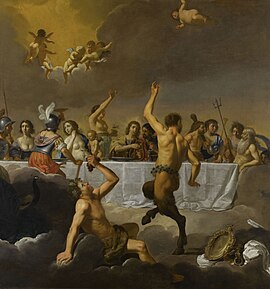| The Feast of the Gods | |
|---|---|
| French: Le Festin des dieux | |
 | |
| Artist | Jan van Bijlert |
| Year | c. 1635–1640 |
| Subject | The feast of the Gods |
| Location | Musée Magnin, Dijon |
| Owner | French state |
| Website | musee-magnin |
The Feast of the Gods (French: Le Festin des dieux) is a painting by the Dutch painter Jan van Bijlert, created around 1635–1640. It is in the Musée Magnin in Dijon, France.
It is one of a number of pictures in western art to depict the feast of the Gods, in this case at the marriage of Thetis and Peleus, with Bacchus in the foreground, and a prominent dancing satyr.
The left-hand side of the painting is lost.
History
The painting represents the popular mythological subject the feast of the Gods, and has been the property of the French Republic since the bequest of the collector Maurice Magnin (1861–1939) in 1938.
The painting came to public attention following a controversy sparked by the 2024 Summer Olympics opening ceremony. During the ceremony, the singer Philippe Katerine made an appearance dressed as almost naked blue Bacchus, with silver spangles and a saffron beard, half-reclining behind a cheese platter, on a platter of colourful fruits and flowers, arranged in offering in the centre of a long banquet table, bringing together different characters including a number of drag queens, stationed behind him. This tableau was widely claimed by some art historians and on social media to be a reference to the well-known painting The Last Supper by Leonardo da Vinci, a claim repeated by many press outlets, but other art historians and the creator himself asserted that it was a reference to The Feast of the Gods.
Description
The painting represents a banquet taking place on Mount Olympus to celebrate the marriage of Thetis, a nereid, and Peleus, king of Phthia, in which many gods from Greco-Roman mythology participate. In the centre, Apollo is crowned and holds a lyre. In the left part we can recognize Minerva, Diana, Mars, Venus, and Cupid and, behind, Flora, the goddess of spring. On the right are Hercules and Neptune, as well as Eris, recognizable by the golden apple of discord that she brought as revenge for not having been invited. In the foreground are a dancing satyr and Bacchus, eating a bunch of grapes.
The left part of the painting has been cut off, explaining the absence of certain gods. For example, Juno's peacock is present, but not the goddess herself.
References
- "Le Festin des Dieux" (in French). Archived from the original on 29 July 2024. Retrieved 29 July 2024.
- "An Olympics Scene Draws Scorn. Did It Really Parody 'The Last Supper'?". The New York Times. 8 July 2024. Retrieved 30 July 2024.
- "JO 2024 : Zinédine Zidane, Lady Gaga, Céline Dion, un spectacle total sur la Seine et le déluge… Paris s'offre une cérémonie d'ouverture inoubliable". Le Monde (in French). 27 July 2024. Retrieved 29 July 2024..
- "La cérémonie d'ouverture des JO de Paris enthousiasme la gauche mais indigne une partie de la droite et de l'extrême droite". Le Monde (in French). 27 July 2024. Retrieved 29 July 2024..
- "Cérémonie d'ouverture de Paris 2024 : "Une image comme ça, on n'aurait jamais pu la créer, même au cinéma"". France Inter (in French). 27 July 2024. Retrieved 29 July 2024..
- "JO 2024: la drag-queen Piche répond aux critiques après sa performance à la cérémonie d'ouverture". RMC Sport Jeux Olympiques (in French).
- "JO 2024 : Thomas Joly s'est-il inspiré de « la Cène » ou du « Festin des dieux » ?". 20 Minutes (in French). 28 July 2024. Retrieved 29 July 2024.
- Dassonville, Aude (28 July 2024). "JO 2024 : ce que l'on n'a pas vu de la cérémonie d'ouverture et ce que certains ont voulu voir". Le Monde (in French). Retrieved 29 July 2024.
- Henley, Jon (29 July 2024). "Olympic 'Last Supper' scene was in fact based on painting of Greek gods, say art experts". The Guardian. Retrieved 30 July 2024.
- ^ "The Feast of the Gods". Musée Magnin. Retrieved 29 July 2024.